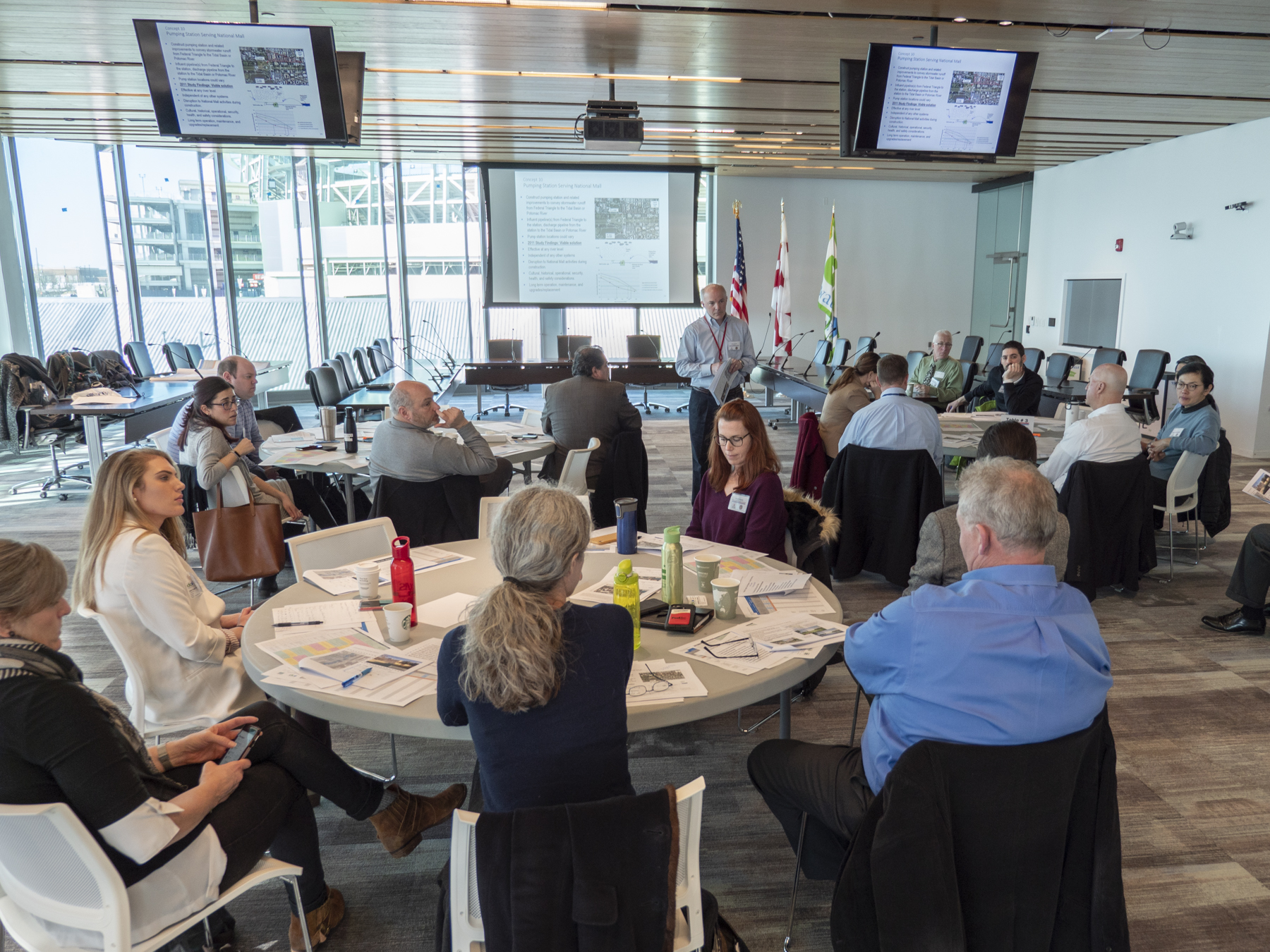Team Activities
DC Levee System and Flood Preparedness Public Outreach
The U.S. Army Corps of Engineers and National Park Service hosted a public meeting the evening of Oct. 30, 2018 in Southwest D.C. to share information with attendees on the results of a safety risk assessment completed for the District of Columbia Levee System, also referred to as the Potomac Park Levee. D.C. Homeland Security and Emergency Management Agency also presented on flood preparedness measures for property and business owners/renters and evacuation procedures. The purpose of this meeting was to improve the public's understanding of flood risk in the area as well as to educate residents and businesses on steps they can take to prepare for and reduce damages from flooding. This meeting was held as part of a nationwide effort the Corps is leading to individually assess levees across the nation to determine their safety risks and present this information to the public. The information that goes into a risk assessment includes how often the area may flood; the condition of the levee system; and the population and development (including critical infrastructure) at risk behind the levee system.
Public Meeting Materials
*Click on the yellow comment icon on upper lefthand side of presentation slides to view notes.
Federal Triangle Area Flooding
The DC Silver Jackets initiated an interagency project in FY18 to re-engage stakeholders and determine a path forward for reducing the flood risk. The Federal Triangle, which is comprised of federal and district buildings, experienced severe flooding and millions of dollars in damages in the June 2006 flood and then flooded again in July 2019. Some flood studies have been completed, however, the recommended solutions are costly and no agencies have moved forward with a comprehensive project. The intent of this project is to bring the myriad of stakeholders together to understand the flood risk, strategize potential innovative solutions, and determine a path forward for further study and design.
Two Federal Triangle Area Flood Workshops were held at the University of the District of Columbia, on June 6 and September 5, 2018 (see links to summary report and presentations below). The intent of the first workshop was to provide attendees with an overview of the flood history and risk in the Federal Triangle; discuss steps individual agencies are taking to flood proof their properties; present on types of interior flood risk management measures; and engage on key opportunities and challenges related to interior flooding in the area. The second workshop focused on potential flood risk management solutions.
In May 2019, the key stakeholder agency leaders met to discuss the results of the two workshops and to decide on a path forward. The agency leaders showed support for moving forward collectively with studying comprehensive solutions to the flooding problem. They committed to support several short-term tasks by providing data and personnel and agreed to work towards scoping and funding strategies for a longer-term feasibility study.
Following the leadership meeting, the DC Silver Jackets team hosted an interagency charrette on February 21, 2020 with key public agency stakeholders with facility management and/or operational responsibilities to further evaluate the flood risk management alternatives. The charrette summary and presentation is below.
Federal Triangle Area Flood Workshops
June 6, 2018 Workshop Presentations
- Federal Triangle Workshop 1 Summary (pdf, 1.3 MB)
- Workshop 1 Agenda (pdf, 761 KB)
- Federal Triangle Overview by National Capital Planning Commission (pdf, 10.1 MB)
- DC's Flood History by National Weather Service (pdf, 16.6 MB)
- Federal Triangle Flood Risk by DC Water and Sewer Authority (pdf, 2.2 MB)
- Panel Facilities: Smithsonian Institution (pdf, 3.3 MB)
- Panel Facilities: Washington Metropolitan Area Transit Authority (pdf, 4.6 MB)
- Panel Facilities: National Archives and Records Administration (pdf, 1.5 MB)
- Panel Facilities: National Gallery of Art (pdf, 2.4 MB)
- Panel Facilities: General Services Administration (pdf, 9.7 MB)
- Types of Interior Flood Risk Management Measures (pdf, 2.7 MB)
- Stream Restoration Project in Cheonggyecheon by Seoul Metropolitan Government (pdf, 6.5 MB)
- Federal Triangle Drainage Area Map (pdf, 17.7 MB)
- Federal Triangle Flood Area and Imagery (pdf, 4.3 MB)
September 5, 2018 Workshop Presentations
- Federal Triangle Workshop 2 Summary (pdf, 1.0 MB)
- Workshop 2 Agenda (pdf, 0.6 MB)
- DC Water: Federal Triangle Stormwater Drainage Study, Flood Risk Mitigation Alternatives (pdf, 4.0 MB)
- National Mall Coalition: National Mall Underground (pdf, 16 MB)
- Ramboll: Integrated Resiliency Planning (pdf, 10.2 MB)
- Karolina Kawiaka: Restoring the Role of the Tiber Creek, Flood Adaptation for the Federal Triangle (pdf, 4.8 MB)
- District of Columbia "Potomac Park" Levee Risk Communication (pdf, 6.3 MB)
- HSEMA: DC Hazard Mitigation (pdf, 0.2 MB)
- Federal Triangle Flood Area and Imagery (pdf, 4.3 MB)
Federal Triangle Area Flood Charrette, February 21, 2020


Federal Triangle Area Interior Flooding: Preliminary Flood Damage and Impact Assessment
After completion of the charrette, a preliminary damage and impact assessment was undertaken by USACE and the DC Silver Jackets team to help inform decision makers regarding the potential costs and benefits of implementing an area-wide flood risk management project for the Federal Triangle Area (FTA). The study summarizes the flood damages and impacts data the team was able to compile for the 17 buildings/infrastructure assets in the FTA, however the existing and potential future damages data were incomplete or inconclusive for various reasons. Although the study results were ultimately inconclusive, this preliminary assessment compiled the best known data on flooding vulnerabilities and impacts to the buildings and infrastructure in the FTA and should serve as a stepping stone for additional study.
Watts Branch Flood Risk Management Study
The District of Columbia Silver Jackets has completed a multi-year flood risk management study for neighborhoods along Watts Branch, which is a tributary of the Anacostia River, in the northeast corner of the District of Columbia. These neighborhoods are in a special flood-hazard area (within the 100-year floodplain) and consist of high-density residential and non-residential structures and critical infrastructure, including a public housing development. These high-risk flood zone areas will likely expand even further. A flood in an area with lower resiliency can have a devastating impact on the residents and community, including the loss of jobs and displaced residents.
The study results will help the District of Columbia achieve flood-risk reduction goals within their All-Hazard Mitigation Plan. The D.C. Climate Adaptation Plan also identified Watts Branch as one of four priority areas within the District to be addressed.
The study assessed existing flood risks and future flood risks; updated floodplain maps which will allow the community and local organizations to better understand their flood risk; identified individual and watershed-wide flood risk management strategies and neighborhood climate-resilience policies and strategies; and study partners participated in outreach activities to raise awareness of flood risk and promote risk-reduction actions.
Partner agencies include the U.S. Army Corps of Engineers; D.C. Office of Planning; D.C. Water; D.C. Department of Energy and Environment; Department of Consumer and Regulatory Affairs; D.C. Homeland Security and Emergency Management Agency; Environmental Protection Agency; National Weather Service; Federal Emergency Management Agency; U.S. Geological Survey; and Georgetown University.